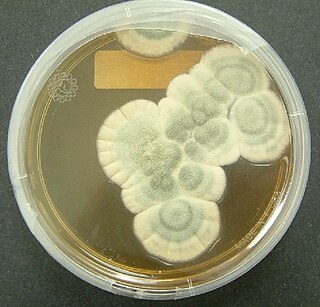
Penicillium is a genus of ascomycetous fungi that is part of the mycobiome of many species and is of major importance in the natural environment, in food spoilage, and in food and drug production.

Griseofulvin is an antifungal medication used to treat a number of types of dermatophytoses (ringworm). This includes fungal infections of the nails and scalp, as well as the skin when antifungal creams have not worked. It is taken by mouth.
In enzymology, a 6-methylsalicylic-acid synthase (EC 2.3.1.165) is a polyketide synthase that catalyzes the chemical reaction
Karl Hult(born 1944) is a Swedish biochemist and researcher. He is a professor emeritus at the Royal Institute of Technology, Stockholm, Sweden, and has contributed to research within the fields of metabolism and biocatalysis.

Penicillium chrysogenum is a species of fungus in the genus Penicillium. It is common in temperate and subtropical regions and can be found on salted food products, but it is mostly found in indoor environments, especially in damp or water-damaged buildings. It has been recognised as a species complex that includes P. notatum, P. meleagrinum, and P. cyaneofulvum, but molecular phylogeny established that it is a distinct species and that P. notatum is P. rubens. It has rarely been reported as a cause of human disease. It is the source of several β-lactam antibiotics, most significantly penicillin. Other secondary metabolites of P. chrysogenum include roquefortine C, meleagrin, chrysogine, 6-MSA YWA1/melanin, andrastatin A, fungisporin, secalonic acids, sorbicillin, and PR-toxin.

Verrucosidin is a toxic pyrone-type polyketide produced by Penicillium aurantiogriseum, Penicillium melanoconidium, and Penicillium polonicum.

Citromycin is a chemical compound produced by Penicillium. It was first discovered in 1969 and was found to have weak antibiotic activity.

Citromycetin is a bio-active polyketide isolated from Australian Penicillium.
Penicillium aethiopicum is a fungus species of the genus of Penicillium. Penicillium aethiopicum produces viridicatumtoxin and griseofulvin, two structurally interesting polyketides.
Penicillium antarcticum is an ubiquitous, endophytic fungus species of the genus Penicillium. Penicillium antarcticum produces the polyketide compounds antarone A and antarone B.
Penicillium brefeldianum is an anamorph fungus species of the genus of Penicillium which produces Brefeldin A a fungal metabolite.
Penicillium brocae is a fungus species of the genus of Penicillium which was isolated in Chiapas in Mexico.Penicillium brocae produces brocazine A, brocazine B, brocazine C, brocazine D, brocazine F, bisthiodiketopiperazine and the polyketides brocaenol A, brocaenol B, brocaenol C
Penicillium freii is a psychrophilic species of the genus of Penicillium which produces xanthomegnin and patulin. Penicillium freii occurs in meat, meat products, barley and wheat
Penicillium herquei is an anamorph, filamentous species of the genus of Penicillium which produces citreorosein, emodin, hualyzin, herquline B, janthinone, citrinin and duclauxin,.
Penicillium minioluteum is an anamorph species of the genus Penicillium which produces dextranase, miniolin A, miniolin B and miniolin C.
Penicillium multicolor is an anamorph species of the genus Penicillium which produces alpha-L-fucosidase, tilactase, sclerotiorin, 8-O-Methylsclerotiorinamine, multicolosic acid and isochromophilones.
Penicillium raistrickii is an anamorph species of fungus in the genus Penicillium which produces griseofulvin, patulin and verruculogen.
Penicillium striatisporum is an anamorph species of fungus in the genus Penicillium which was isolated from the rhizosphere of chilli peppers. Penicillium striatisporum has an selective antifungal activity against Candida albicans This species produces striatisporin A, striatisporolide A, versiol, calbistrin C, deformylcalbistrin A, citromycetin, citromycin, fulvic acid, (-)-2,3-dihydrocitromycetin and (+)-hexylitaconic acid
Penicillium turbatum is an anamorph species of fungus in the genus Penicillium which was isolared from Taxus baccata. Penicillium turbatum produces pipolythiopiperazinedione-antibiotics, hyalodendrin A and hadacitin.
Penicillium velutinum is an anamorph species of fungus in the genus Penicillium which was isolated from soil in the United States. Penicillium velutinum produces verruculogen, verrucosidin, verruculotoxin, decalpenic acid, dehydroaltenusin, cyciooctasulfur, atrovenetinone, altenusin and penitrem A






